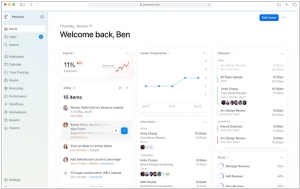CloudForms vs Morpheus
March 10, 2025 | Author: Michael Stromann
10★
Red Hat CloudForms is an infrastructure management platform that allows IT departments to control users' self-service abilities to provision, manage, and ensure compliance across virtual machines and private clouds.
8★
Morpheus is a leading cloud application management and orchestration platform designed from the ground up for truly agnostic cloud management. Morpheus gives developers, IT managers, and DevOps professionals full control over both VM and container-based systems across any cloud or infrastructure. 100% agnostic multi cloud management for Hybrid IT. Enable self-service provisioning and DevOps automation for VMware, Kubernetes, OpenStack, AWS, Azure, and more.
See also:
Top 10 Cloud Management platforms
Top 10 Cloud Management platforms
CloudForms and Morpheus are both cloud management platforms, which is a bit like saying that a spoon and a forklift are both tools for moving things around. They let IT teams wrangle hybrid and multi-cloud environments, provide self-service portals so developers can launch virtual machines without having to sacrifice a goat to the sysadmin and enforce policies so things don’t descend into complete chaos. Both integrate with automation tools like Ansible and Terraform, which is excellent because typing the same commands repeatedly is only fun for about ten minutes. Above all, they exist to prevent cloud sprawl—the terrifying phenomenon where companies wake up one day and realize they’ve somehow deployed more virtual machines than they have employees.
CloudForms, brought to life by Red Hat in 2010, is a fine choice for those deeply entrenched in the Red Hat ecosystem, particularly OpenStack and OpenShift users who enjoy a good bit of automation with their cloud wrangling. It’s built on ManageIQ, which sounds a lot fancier than just saying "open-source cloud manager." While it once held a proud place in the Red Hat lineup, it now finds itself being gently nudged toward the great software retirement home in the sky, with Red Hat focusing more on Ansible Automation Platform instead. It’s had a good run, but like an old cat that’s stopped chasing mice, its days are numbered.
Morpheus, on the other hand, was born in 2015 and has spent its life being slightly more adaptable, like a particularly clever octopus. Designed for enterprises, DevOps teams and MSPs, it cheerfully supports a wider range of cloud providers, from AWS and Azure to GCP and Kubernetes, without breaking a sweat. It also does fancy things like cost analytics, database provisioning and container management, which is great for companies that enjoy knowing where their money is going. Unlike CloudForms, it is not being put out to pasture anytime soon, meaning it remains a strong contender for those who like their cloud management platforms alive, well and not contemplating retirement.
See also: Top 10 Cloud Management platforms
CloudForms, brought to life by Red Hat in 2010, is a fine choice for those deeply entrenched in the Red Hat ecosystem, particularly OpenStack and OpenShift users who enjoy a good bit of automation with their cloud wrangling. It’s built on ManageIQ, which sounds a lot fancier than just saying "open-source cloud manager." While it once held a proud place in the Red Hat lineup, it now finds itself being gently nudged toward the great software retirement home in the sky, with Red Hat focusing more on Ansible Automation Platform instead. It’s had a good run, but like an old cat that’s stopped chasing mice, its days are numbered.
Morpheus, on the other hand, was born in 2015 and has spent its life being slightly more adaptable, like a particularly clever octopus. Designed for enterprises, DevOps teams and MSPs, it cheerfully supports a wider range of cloud providers, from AWS and Azure to GCP and Kubernetes, without breaking a sweat. It also does fancy things like cost analytics, database provisioning and container management, which is great for companies that enjoy knowing where their money is going. Unlike CloudForms, it is not being put out to pasture anytime soon, meaning it remains a strong contender for those who like their cloud management platforms alive, well and not contemplating retirement.
See also: Top 10 Cloud Management platforms





